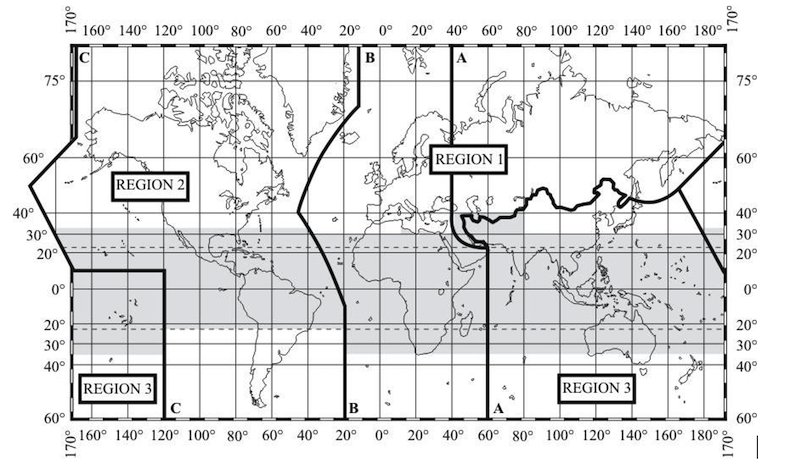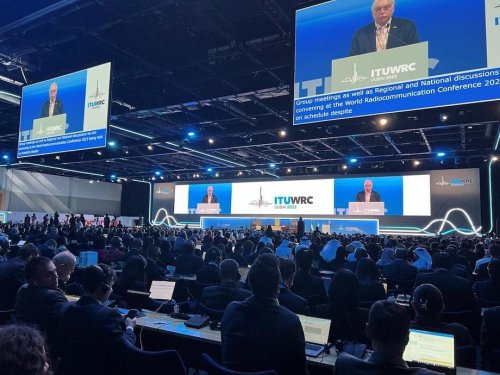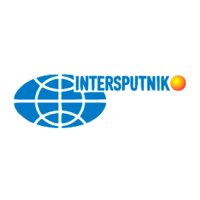WRC-23 has summed up the results of four-year research and lively discussions in ITU working groups and introduced a number of changes to the Radio Regulations, which defined a new regulatory framework for using the radio frequency spectrum at the global level. At the Conference, representatives of the Intersputnik International Organization of Space Communications took active part in the work of committees, meetings of heads of delegations, working and sub-working groups, as well as other events at the ITU site, in particular, in the round table of the Global Association of Satellite Operators on the protection of critical satellite applications, stimulation of innovation and development of new space services.
Key Results of WRC-23
Industry experts agree that in general WRC-23 had a positive outcome for satellite services. However, a number of issues that had been vigorously lobbed by other services were decided adversely for the satellite industry. The true extent of the resulting changes in the use of radio spectrum will become clear in the coming years. The following key decisions of WRC-23 that are directly related to the activities of satellite operators should be highlighted:
Agenda Items 1.2 and 1.3
In agenda item 1.2, the 3.6-3.7 GHz frequency band was allocated in favour of the International Mobile Telecommunications (IMT). The decision applies to fourteen Region 2 countries (ITU regions are shown in Figure 1). The 6.425-7.125 GHz frequency band was allocated in favour of IMT to two Region 2 countries and three Region 3 countries. However, the applicable protection criteria are not satisfactory and may become the subject of discussions by ITU working groups for subsequent changes at WRC-27. In item 1.3, the 3.6-3.8 GHz frequency band was allocated to IMT for most member countries of the African Telecommunication Union and the Arab Spectrum Management Group. An exception was made for six African states where the 3.7-3.8 GHz frequency band would continue to be used by the Fixed Satellite Services (FSS) on a secondary basis.

Fig. 1. ITU’s classification of countries.
Agenda Item 1.8
This concerns the possible use of FSS networks to control unmanned aircraft systems. For this agenda item, it was decided to make no amendments to the Radio Regulations due to insufficient development of the current regulatory framework to maintain relevant systems. The finalisation of necessary recommended practices and standards was entrusted to the International Civil Aviation Organization (ICAO). A new attempt to consider the possibility of using the 5 GHz frequency band for these purposes will be made at WRC-31.
Agenda Items 1.15 and 1.16
For each of the two agenda items, a new resolution was adopted that would ensure the operation of air and sea earth stations in motion (ESIM) communication with geostationary satellite systems in the Ku-band and non-geostationary satellite systems in the Ka-band. Such an innovation entails a huge amount of work associated with coordinating the two satellite services to avoid mutual interference. This change can be considered positive for the satellite industry in general, as due to the ESIM communication with geostationary (GSO) and non-geostationary (NGSO) systems, a new segment of satellite services will emerge.
Agenda Item 1.18
This agenda item addressed spectrum requirements and possible new frequency allocations to the mobile satellite service (MSS). As a result of discussions at WRC-23, it was decided not to allocate additional spectrum to the MSS for low-speed/narrowband systems (IOT), as such applications had not been properly described and studies on this issue had not been completed. Therefore, the 1695-1710 MHz, 2010-2025 MHz, 3300-3315 MHz and 3385-3400 MHz frequency bands continue to be used by services to which they have been primarily allocated.
Agenda Item 1.19
This item concerns a new primary frequency allocation to the FSS (subject to the protection of existing services). The decision to allocate the 17.3-17.7 GHz frequency band to the FSS for Region 2 in the space-to-Earth direction contributes to the dynamically developing satellite industry, and additional orbital frequency resources can be used for new applications.
Agenda Item 7 (Issue J)
Issue J of Agenda Item 7 concerns the compliance with total equivalent power flux density limits established by Resolution 76. This takes into account the current lack of clear recommendations and procedures to ensure compliance with these requirements by NGSO systems. WRC-23 initiated a consultation process to develop appropriate recommendations and procedures that could become valid if adopted by a future WRC. Completion of this issue is expected by July 2027. The entry into force of such recommendations and procedures are expected to be an important step towards protection of GSO satellite systems from potential interference by NGSO systems.
Start of a New Cycle and Agenda of WRC-27
WRC-23 was not only the completion of a four-year working cycle on the agenda items approved by WRC-19, but also determined a new current agenda. It will be discussed by the international industry community at WRC-27. However, of 37 proposed issues, only 13 were included in the agenda of the next WRC. Among these items, we would like to highlight the ones mostly affecting interests of the satellite industry, as well as Intersputnik’s Members and Signatories:
Agenda Item 1.1 of WRC-27
As clear regulatory frameworks for using the C-, Ku- and Ka-band are established, the Q/V-band is gaining increasing interest, including for use by air and sea earth stations in motion and interacting with FSS space stations. Item 1.1 of WRC-27 proposes that the technical and operational conditions for using the 47.2-50.2 GHz and 50.4-51.4 GHz frequency bands (Earth-to-space) or their parts by such stations be considered.
Agenda Item 1.2 of WRC-27
It is planned to consider revising the sharing conditions for the 13.75-14 GHz frequency band to allow the use of uplink fixed-satellite service earth stations with smaller antennas. This decision would have a positive impact on the satellite communications market by providing satellite operators with greater flexibility to create different network architectures operating in the above frequencies.
Agenda Item 1.4 of WRC-27
This item concerns a possible new primary allocation to the fixed-satellite service (space-to-Earth) in the 17.3-17.7 GHz frequency band and a possible new primary allocation to the broadcasting satellite service (BSS) (space-to-Earth) in the 17.3-17.8 GHz frequency band in Region 3 (subject to the protection of existing primary allocations in the same and adjacent frequency bands). In addition, it is planned to consider equivalent power flux density limits to be applied in Regions 1 and 3 to non-geostationary satellite systems in the fixed-satellite service (space-to-Earth) in the 17.3-17.7 GHz frequency band. Provided that a clear regulatory framework and protection criteria are established, such a new distribution in favour of the FSS and BSS can be used to increase the volume of services provided and introduce new ones.
Agenda Item 1.5 of WRC-27
In this item, regulatory measures and the possibility of their implementation are subject to consideration to limit the unauthorised operation of earth stations of NGSO FSS and MSS systems, as well as related issues about their service areas. Unauthorised use of earth stations is a common problem that affects the interests of all satellite services market players and impedes the efficient use of orbital and frequency resources. Specific measures to counter such unauthorised connections will be proposed and considered within ITU working groups, after which, at WRC-27, they will be approved at the international level.
Agenda Item 1.6 of WRC-27
It is proposed that technical and regulatory measures for satellite networks/FSS systems in the 37.5-42.5 GHz (space-to-Earth), 42.5-43.5 GHz (Earth-to-space), 47 .2-50.2 GHz (Earth-to-space), and 50.4-51.4 GHz (Earth-to-space) frequency bands be considered to ensure equitable access to these frequency bands. The issue is directly related to the general availability of the radio frequency spectrum for the introduction of new services by satellite operators and the development of existing ones using the Q/V range.
Agenda Item 1.7 of WRC-27
The results of sharing and compatibility studies will be considered to develop technical specifications for the use of IMT in the 4400–4800 MHz, 7125–8400 MHz (or parts thereof) and 14.8-15.35 GHz frequency bands, taking into account existing primary services operating in the same and adjacent frequency bands. Just as at WRC-23, other services are also seeking opportunities to gain access to additional frequency resources. However, frequency sharing, even with the most positive research results, entails many practical difficulties and implies close interaction between the services allowed for such sharing. Therefore, the main objective of the satellite industry will be to prevent a positive decision on this issue if its interests are not fully taken into account in the proposed conditions.
Agenda Items 1.13 and 1.14 of WRC-27
In relation to these agenda items, it is proposed that the results of studies of possible new allocations to the mobile satellite service for direct connectivity between space stations and IMT user equipment in addition to coverage of terrestrial IMT networks be considered. In addition, possible further allocations to the mobile satellite service will be discussed. As with agenda item 1.7 of WRC-23, interests in the development of IMT and MSS must be carefully coordinated with the interests of other existing services.
Over the next four years, relevant research will be carried out on issues included in the WRC-27 agenda by ITU study groups, which are planned to be taken into account in the discussions and development of methods by ITU working groups. In parallel, to determine preliminary positions, the proposed methods will be studied by regional communications organisations. It is noteworthy that about 80% of the studies to be carried out by ITU in preparation for WRC-27, in one way or another, relate to satellite services and the frequencies allocated to them. It is evident that the next four years will be the period of active work and discussions that will determine the further development of the radio frequency regulation. Intersputnik will continue to participate in ITU working groups and regional communications organisations to ensure that its Members and Signatories are informed and their interests protected.
**
 Operations Committee
Operations Committee
